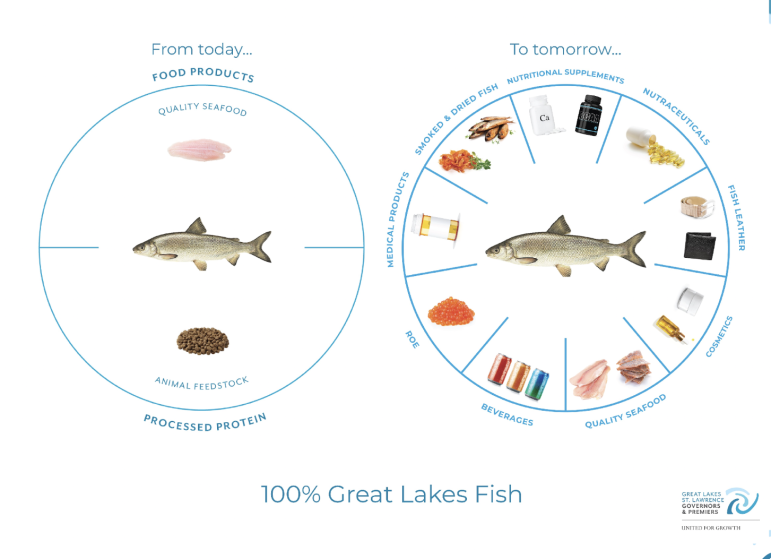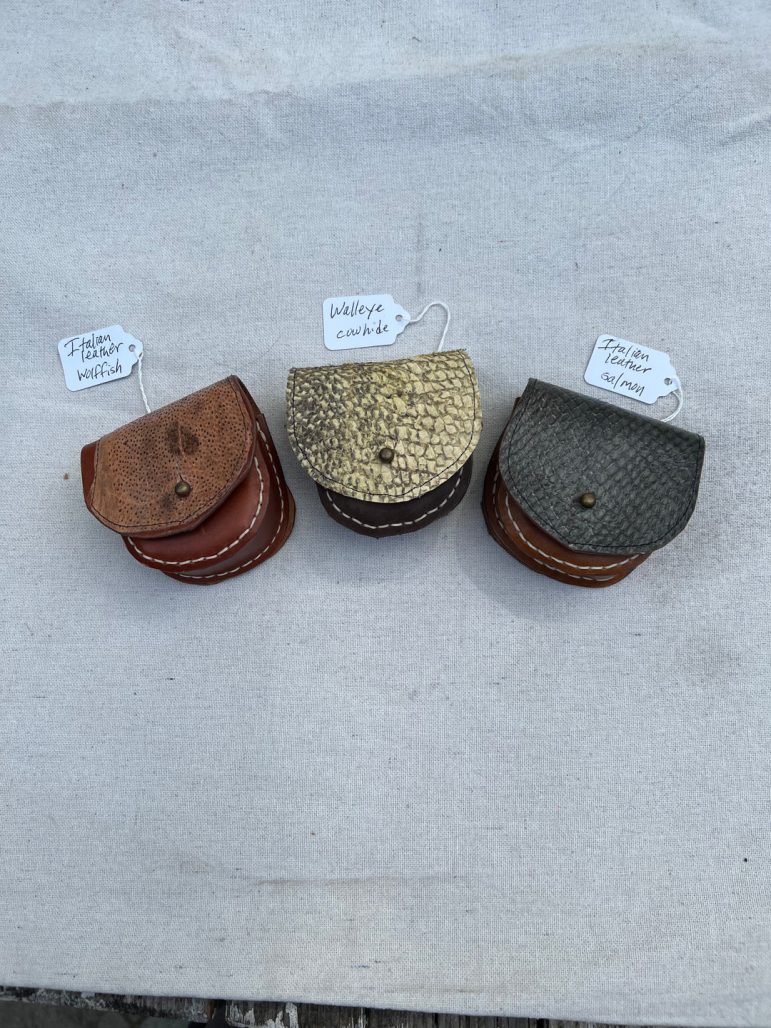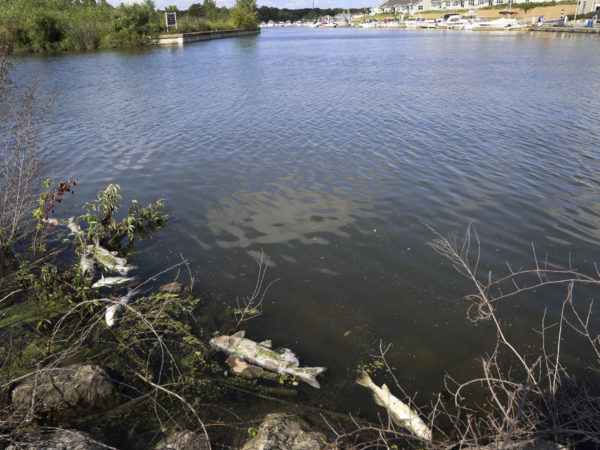
This article was republished here with permission from Great Lakes Echo.
By Shealyn Paulis, Great Lakes Echo
Fish-leather purses and wallets may make their way into Great Lakes fashion with an initiative to use 100% of commercially caught fish by 2025.
One of the latest projects of a binational Great Lakes organization is to fully use the region’s whitefish, lake trout, yellow perch, walleye and white sucker. David Naftzger, executive director for the Conference of Great Lakes St. Lawrence Governors & Premiers, recently signed the 20th company to the 100% fish pledge. The conference consists of leaders of eight states and two Canadian provinces bordering the Great Lakes. It was founded in 1983 to grow the regional economy and protect the world’s largest surface freshwater system.
The pledge exposes people to the number of ways to use a fish, Naftzger said.
“There are food products you can make out of non-traditional parts of the fish, but also to show that you can use so much more of each fish, and that a fish is not just a filet.” Naftzger said.
Usually commercially caught fish are primarily used for their filets to eat, according to the project details. About 60% of the remaining fish becomes low-value animal feed or is discarded.

Fish Charts; These charts show how commercially caught fish are now used and what could be possible if they were fully used. Image: The Conference of Great Lakes St. Lawrence Governors & Premiers
Commercial fisheries in the Great Lakes region are undervalued and underused, according to the project managers.
The project team also involves Native American communities: The Red Cliff Fish Co., Chippewa Ottawa Resource Authority, Grand Traverse Band of Ottawa and Chippewa Indians, Great Lakes Indian Fish & Wildlife Commision and the Little Traverse Bay Bands of Odawa Indians.
Commercial Great Lakes fishing is a $7 billion industry. Using 100% of commercially caught fish means expanding and sustaining an already profitable lake economy and culture. This pledge details how a fish can be turned into products, increasing profits and eliminating waste.

Fish Value Machine; This graphic demonstrates the range of ways each part of a fish can be used. Image: Iceland Ocean Cluster
Fish skin can be turned into leather and artistic materials, the project explains Collagen from a fish can be used as pharmaceutical supplements. Oils and collagen can also be used in cosmetics and creams. Fish skins have also been used to treat burn victims, as they have anti-inflammatory and anti-bacterial properties that support and improve wound healing. The nutrients from their meat and bones can be turned into medications and collagen beverages. Anything leftover can be turned into organic liquid fertilizer.
The project is inspired by the Iceland Ocean Cluster, a group that pioneered and operates a similar campaign in Iceland. As a result of this initiative, over 90% of each fish is consumed or processed.
A study by the Iceland Ocean Cluster suggests that promising sites for research and development of the full use of fish could be located in the Great Lakes region near Wheatley, Ontario; Mackinaw City, Michigan, and between Duluth, Minnesota and Superior, Wisconsin. These locations are near urban areas, fisheries and processing plants, fish restaurants and research centers/universities.
Bill Bodin, a fourth generation commercial fisherman whose family has been fishing near the Apostle Islands of Lake Superior since the 1880s said he already uses 100% of the fish he catches..
Since sustainability is nothing new to him, Bodin says he has more goals for his involvement in the program and wants “to see these leaders working to create a larger enterprise to promote sustainability, healthy fish populations and utilizing the resources to a maximum is a breath of fresh air.”
Bodin says he hopes that this could lead to new product markets and opportunities, avoiding putting most of the parts of fish that are not eaten into compost.
“At this point, I’m hopeful that the pledge will help create additional markets around collagen, fish oil, fish scales, fish skin,” said Bodin. These are “things we’re not currently taking full advantage of.”
Joe and Pam Manthei own and operate Fiskur Leather, a company that uses fish scraps to create leather for clothing, artistic materials or jewelry.

Leather Pouches; These small pouches are one of many different products made of fish leather for purchase online. Image: Joe Manthei
The couple learned about tanning fish skins in 2011 while on vacation in Iceland and brought the idea home with them to the United States.
They first imported Icelandic fish to work with, but being from Minnesota themselves they soon found that Bodin Fisheries was willing to send scraps to experiment with, Joe Manthei said.
He processes and tans the fish and his wife, Pam, creates the artistic materials from the leather. Together, they create wallets, boots, bags, beads, buttons and jewelry.
“The interesting thing is, it’s very thin but extremely durable.” Joe Manthei said.
Fish leather is regarded as one of the strongest and most durable, he said. This is due to the structure of the skin, as fish skin runs crosswise rather than parallel.
“We are using some of the products that might normally be thrown away,” Joe Manthei said. “I’m in favor of everything it [the pledge] is doing.”
Naftzger said that the 100% Great Lakes Fish pledge is a non-traditional collaboration between native tribes, commercial fishing companies, the research community, and international partners to show companies and the public that every fish part tossed out is an opportunity to create new products and rethink value in the fishing industry.
“We’ll be working over the next two years to support the companies that are already using 100% of their fish to move up in the value chain, and for those who are not, help them get to 100% utilization.” Naftzger said, “Over time, we hope to attract new companies and have new products we may not even be thinking about now.
”I’m really looking forward to what we can do.”
Catch more news at Great Lakes Now:
What do Michigan rattlers chow down?
Featured image: Fish Leather; Lake trout and whitefish leather that has been dyed with natural indigo. Image: Joe Manthei




